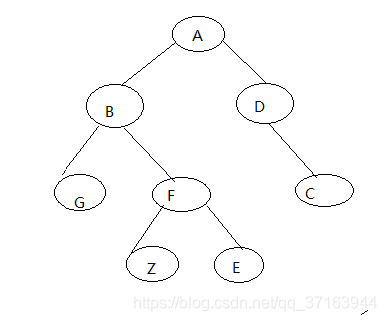1.二叉树的广度遍历(层序便利)

遍历后的结果为 A B D G F C Z E
层序遍历的实现:
申请一个队列 先将根入队列

将根弹出
A
将根的左右孩子入队

将B弹出 将B的左右孩子入栈
A B

重复以上操作直到队列为空
实现代码:
#include<stdio.h>
#include<stdlib.h>
typedef struct node
{
int nValue;
struct node *pLeft;
struct node *pRight;
}BinaryTree;
typedef struct node3
{
BinaryTree* nValue;
struct node3 *pNext;
}MyQueue;
typedef struct node4
{
int nCount;
MyQueue *pHead;
MyQueue *pTail;
}Queue;
void q_Init(Queue **pQueue)
{
*pQueue = (Queue*)malloc(sizeof(Queue));
(*pQueue)->nCount = 0;
(*pQueue)->pHead = NULL;
(*pQueue)->pTail = NULL;
}
void q_Push(Queue *pQueue,BinaryTree* nNum)
{
if(pQueue == NULL)return;
MyQueue *pTemp = NULL;
pTemp = (MyQueue*)malloc(sizeof(MyQueue));
pTemp->nValue = nNum;
pTemp->pNext = NULL;
if(pQueue->pHead == NULL)
{
pQueue->pHead = pTemp;
}
else
{
pQueue->pTail->pNext = pTemp;
}
pQueue->pTail = pTemp;
pQueue->nCount++;
}
BinaryTree* q_Pop(Queue *pQueue)
{
if(pQueue == NULL || pQueue->nCount == 0)return NULL;
MyQueue *pDel = NULL;
BinaryTree* nNum;
pDel = pQueue->pHead;
nNum = pDel->nValue;
pQueue->pHead = pQueue->pHead->pNext;
free(pDel);
pDel = NULL;
pQueue->nCount--;
if(pQueue->nCount == 0)
{
pQueue->pTail = NULL;
}
return nNum;
}
BinaryTree *CreateBinaryTree()
{
BinaryTree *pRoot = NULL;
//根
pRoot = (BinaryTree*)malloc(sizeof(BinaryTree));
pRoot->nValue = 1;
//根的左
pRoot->pLeft = (BinaryTree*)malloc(sizeof(BinaryTree));
pRoot->pLeft->nValue = 2;
//左的左
pRoot->pLeft->pLeft = (BinaryTree*)malloc(sizeof(BinaryTree));
pRoot->pLeft->pLeft->nValue = 4;
pRoot->pLeft->pLeft->pLeft = NULL;
pRoot->pLeft->pLeft->pRight = NULL;
//左的右
pRoot->pLeft->pRight = (BinaryTree*)malloc(sizeof(BinaryTree));
pRoot->pLeft->pRight->nValue = 5;
pRoot->pLeft->pRight->pLeft = NULL;
pRoot->pLeft->pRight->pRight = NULL;
//根的右
pRoot->pRight = (BinaryTree*)malloc(sizeof(BinaryTree));
pRoot->pRight->nValue = 3;
//右的左
pRoot->pRight->pLeft = (BinaryTree*)malloc(sizeof(BinaryTree));
pRoot->pRight->pLeft->nValue = 6;
pRoot->pRight->pLeft->pLeft = NULL;
pRoot->pRight->pLeft->pRight = NULL;
pRoot->pRight->pRight = NULL;
return pRoot;
}
void LevelTraversal(BinaryTree *pTree)
{
if(pTree == NULL)return;
//申请辅助队列
Queue *pQueue = NULL;
q_Init(&pQueue);
q_Push(pQueue,pTree);
while(pQueue->nCount != 0)
{
//弹出 打印
pTree = q_Pop(pQueue);
printf("%d ",pTree->nValue);
//非空左右入队
if(pTree->pLeft != NULL)
{
q_Push(pQueue,pTree->pLeft);
}
if(pTree->pRight!= NULL)
{
q_Push(pQueue,pTree->pRight);
}
}
int main()
{
BinaryTree *pTree = NULL;
pTree = CreateBinaryTree();
LevelTraversal(pTree);
return 0;
}
如何实现每输出一层会输出一个换行
介绍一种方法 利用一个标记

在A后入栈一个标记

每次遇到标记就将\n输出 遇到标记后就将标记重新加入到队列的尾
2.二叉树的深度遍历

深度遍历时这个二叉树的输出为
A B G F Z E D C
循环加栈的方式实现
#include<stdio.h>
#include<stdlib.h>
typedef struct node
{
int nValue;
struct node *pLeft;
struct node *pRight;
}BinaryTree;
BinaryTree *CreateBinaryTree()
{
BinaryTree *pRoot = NULL;
//根
pRoot = (BinaryTree*)malloc(sizeof(BinaryTree));
pRoot->nValue = 1;
//根的左
pRoot->pLeft = (BinaryTree*)malloc(sizeof(BinaryTree));
pRoot->pLeft->nValue = 2;
//左的左
pRoot->pLeft->pLeft = (BinaryTree*)malloc(sizeof(BinaryTree));
pRoot->pLeft->pLeft->nValue = 4;
pRoot->pLeft->pLeft->pLeft = NULL;
pRoot->pLeft->pLeft->pRight = NULL;
//左的右
pRoot->pLeft->pRight = (BinaryTree*)malloc(sizeof(BinaryTree));
pRoot->pLeft->pRight->nValue = 5;
pRoot->pLeft->pRight->pLeft = NULL;
pRoot->pLeft->pRight->pRight = NULL;
//根的右
pRoot->pRight = (BinaryTree*)malloc(sizeof(BinaryTree));
pRoot->pRight->nValue = 3;
//右的左
pRoot->pRight->pLeft = (BinaryTree*)malloc(sizeof(BinaryTree));
pRoot->pRight->pLeft->nValue = 6;
pRoot->pRight->pLeft->pLeft = NULL;
pRoot->pRight->pLeft->pRight = NULL;
pRoot->pRight->pRight = NULL;
return pRoot;
}
typedef struct node1
{
BinaryTree* nValue;
struct node1 *pNext;
}Mystack;
typedef struct node2
{
int nCount;
Mystack *pTop;
}Stack;
void s_Init(Stack **pStack)
{
*pStack = (Stack*)malloc(sizeof(Stack));
(*pStack)->nCount = 0;
(*pStack)->pTop = NULL;
}
void s_Push(Stack *pStack,BinaryTree* nNum)
{
//栈不存在
if(pStack == NULL)return;
Mystack *pTemp = NULL;
pTemp = (Mystack*)malloc(sizeof(Mystack));
pTemp->nValue = nNum;
pTemp->pNext = pStack->pTop;
pStack->pTop = pTemp;
pStack->nCount++;
}
BinaryTree* s_Pop(Stack *pStack)
{
if(pStack == NULL || pStack->nCount == 0)return NULL;
Mystack *pDel = NULL;
pDel = pStack->pTop;
BinaryTree* nNum;
nNum = pDel->nValue;
pStack->pTop = pStack->pTop->pNext;
free(pDel);
pDel = NULL;
pStack->nCount--;
return nNum;
}
void UnRecPreTraversal(BinaryTree *pTree)
{
if(pTree == NULL)return;
Stack *pStack = NULL;
s_Init(&pStack);
while(1)
{
while(pTree)
{
printf("%d ",pTree->nValue);
s_Push(pStack,pTree);
pTree = pTree->pLeft;
}
pTree = s_Pop(pStack);
if(pTree == NULL)break;
pTree = pTree->pRight;
}
}
int main()
{
BinaryTree *pTree = NULL;
pTree = CreateBinaryTree();
UnRecPreTraversal(pTree);
return 0;
}